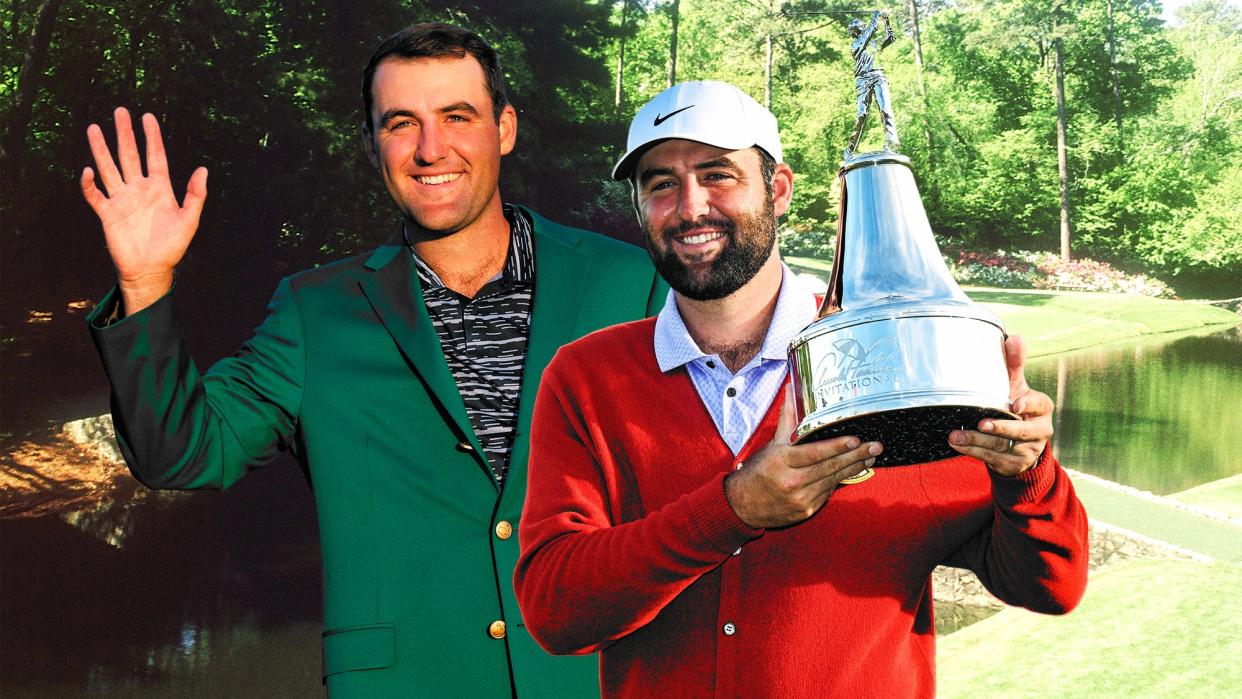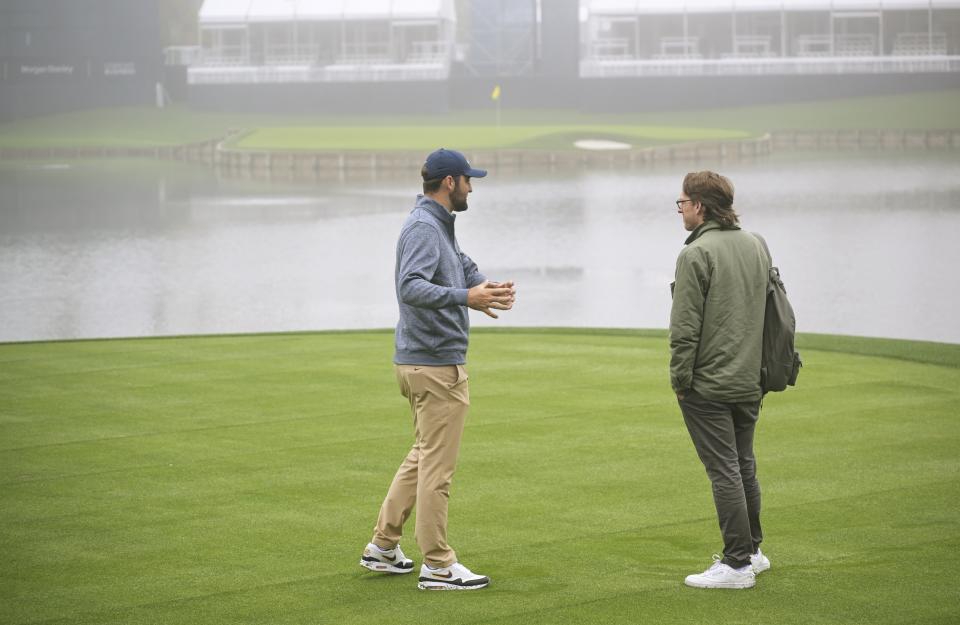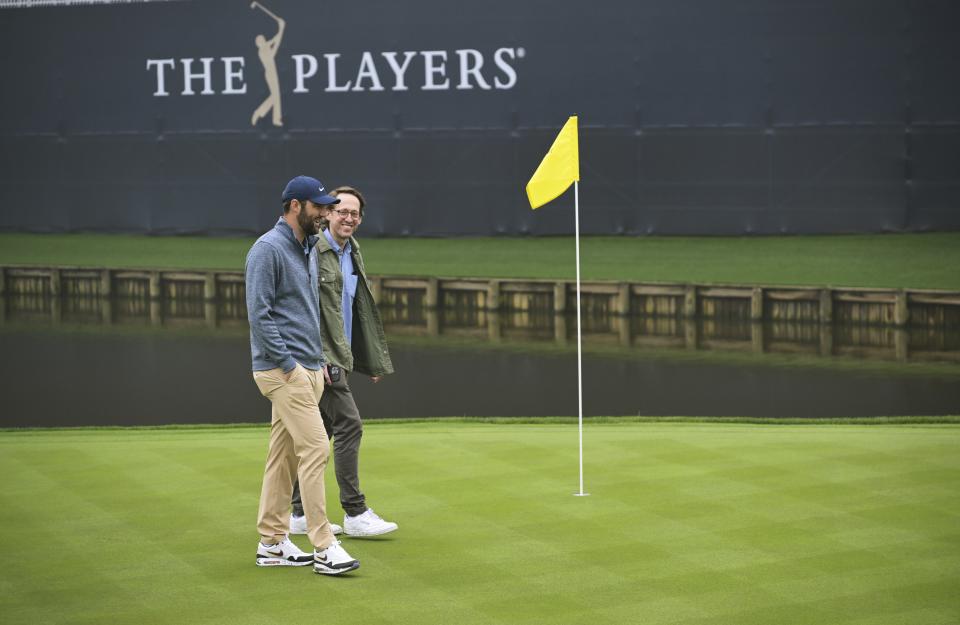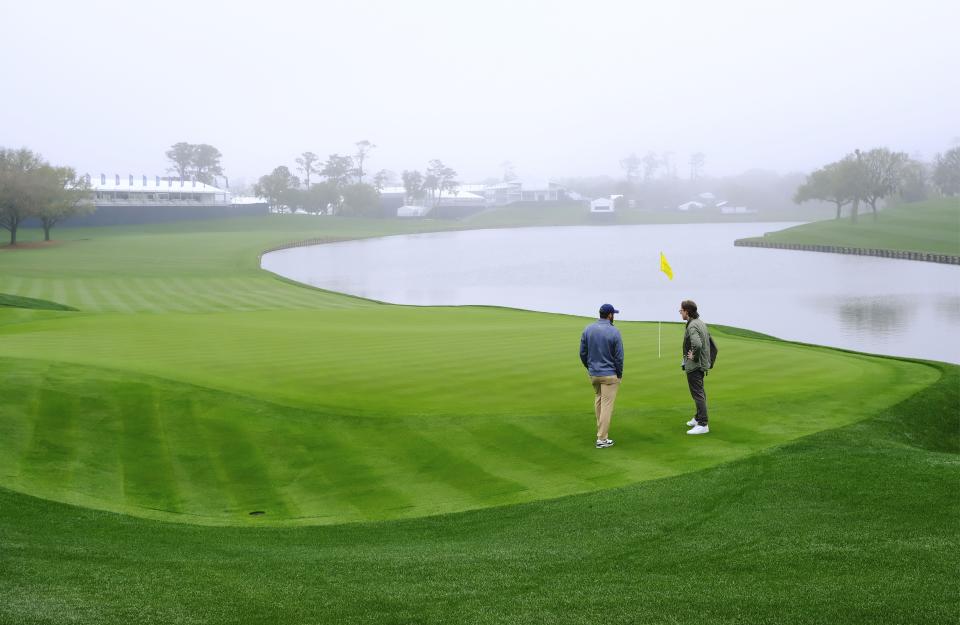Scottie Scheffler, the World's Best Golfer, Just Decided to Start Dominating Again

- Oops!Something went wrong.Please try again later.
- Oops!Something went wrong.Please try again later.
- Oops!Something went wrong.Please try again later.
- Oops!Something went wrong.Please try again later.
Photographs: Getty Images; Collage: Gabe Conte
This story was featured in The Must Read, a newsletter in which our editors recommend one can’t-miss GQ story every weekday. Sign up here to get it in your inbox.
Ever wonder what happens to the green jacket after you win the Masters? Well, if you’re Scottie Scheffler, who won his in 2022, you might wear it around that whole first night—while eating a celebratory cheeseburger from the clubhouse kitchen, while boarding the plane home to Dallas. Maybe you take it off when the cabin gets a little warm, put it back on when the AC starts blasting after take-off. Wear it when your friends come over all week to hang out. And to throw out the first pitch of a Rangers game. And to drop the first puck at a Stars game. Put it back on at Thanksgiving or Christmas to send your Dad a selfie with a Masters mug—just as a reminder of what miracles transpired. Or, whatever, just wear it some Sundays while sitting on the couch watching golf. Then it’s back in your closet, next to all your other fine clothes.
“Wait, did you say fine clothes?” Scottie Scheffler says, laughing. “I don’t have any fine clothes. Just the jacket. And they make you give that back after a year.”
“The winner of the tournament is the only guy who takes their jacket off property all year,” Scheffler explains. “They give you a bunch of rules that come with the jacket, a packet about this thick.” He holds his hands apart about the length of that last putt—his improbable fourth putt on the 72nd green of the 2022 Masters—to win his first major. “You’re not supposed to wear a hat. Definitely no shorts. The right shirt, the right tie. When you’re wearing the jacket outside the club, you’re representing Augusta National. I had to be careful, so we’re not breaking any rules.”
Finally, after your year is up, you bring the jacket back to Georgia when you return to defend your title. Wear it for the pre-tournament Champions Dinner—the Tuesday night tradition when the last winner gets to set the menu. (In Scheffler’s case, there was a cheeseburger slider served “Scottie Style”—that is, with fries stuffed between the patty and the bun.) Then it’ll live the rest of its life in the Champions Locker Room, a quiet existence in rarefied company.
“If you win, you can take it home again,” he says. “If you don’t, it’s gotta stay.”
Scheffler and I are sitting in the clubhouse at TPC Sawgrass, another glorious place in golf entirely, where Scheffler is the defending champion of The Players, the most prestigious non-major on the golf calendar. We’re not far from his new spot in their Champions locker room, revealed to Scheffler just yesterday. But that locker’s empty. No jacket. A different thing. Fewer rules. He’s welcome to drop in any time at Sawgrass—a highest-end public course, but a public facility nonetheless. Despite his past-champion status, he’s still uncertain about what’s permissible at Augusta.
Do they give you anything—a badge, a brain implant—that lets a security guard know you’re allowed on the premises now that you’re technically a member for life?
“No badge, but they give you this metal thing that might help,” he says, not at all convincing himself. “If I walked up to the gates, they probably still wouldn’t let me in.”
The Masters win came during an unprecedented hot streak in modern golf, when, after winning PGA Tour Rookie of the Year in 2020, but failing to take his first Tour victory during the 2021 season, Scheffler rattled off four wins in six starts, including that Masters in April 2022—and six wins in 13 months, through last year’s Players. Scheffler, the current number one player in the world, has the highest floor of anyone in pro golf—almost a sure thing to top-10 week to week, a guarantee to be in the hunt. He is the best ball-striker on earth right now but has been struggling with his putting. The narrative is corrosive. And his sensitivity to the narrative palpable. He’s asked about it in every press conference, in every encounter with a reporter in the wild. Players are talking about it. Podcasts are talking about it. The broadcast is talking about it. Rory McIlroy, world no. 2, was up in the booth after his round at Riviera three weeks ago, suggesting that it’s time for Scheffler to try changing to a mallet-style putter—and the next time Scheffler emerged, at Bay Hill last week, he had indeed changed to a mallet-style putter. That he went on to win by five this weekend is an encouraging sign for Scottie Scheffler—terrifying for any other professional golfer on earth. After all, the winning equation for Scheffler is simple: When he putts average or poorly, he’s still somehow in the mix but isn’t gonna win. When he putts even slightly better than the field average, he can close out a tournament by a half dozen shots.
On the occasion of Scheffler’s return to Sawgrass in anticipation of this year’s Players, starting Thursday, we hit the course to walk and relive the final stretch—and reflect on the Players, the Masters, the spicy PGA Tour-LIV divide, his putting conundrum, and life off the course.
TPC SAWGRASS – 16 TEE
Scheffler and I are standing on the tee box of the Par 5 16th, and he’s miming the sort of sweeping draw you need to rope a golf ball through the gap of trees-left and rough-right that frame the fairway and set yourself up for a second shot into the critical, reachable, water-lined par 5 when you’re coming down the home stretch at Sawgrass.
Now, does this require the baseball follow-through like 13 at Augusta? I ask.
And he laughs, knowing—as anyone who knows knows—just how unorthodox Scheffler looks when he forces himself to hit a golf ball hard right to left.
Scheffler has one of the most unique follow-throughs in all of golf. Not just pro golf. He looks insane by the standards of even a foursome going off at 6 a.m. at your local muni. His feet slide out from under him when he clears his hips and comes through the ball. It looks absolutely like he’s slipping out of his shoes. Or like a three-year-old ballerina trying to keep her balance while twirling. To the reasonable-if-untrained eye, Scheffler’s looks like the least replicable swing on Tour. In reality it is one of the most replicable swings. Because the only thing that matters in Scottie Scheffler’s swing is where the club is at the bottom, at contact. And no one is more consistently in the same position at the bottom of his swing than Scottie Scheffler. Which makes his ball-striking—the driving, the long irons, the mid- and short irons—the most effective in the world right now. What happens after the club makes contact with the ball is a storm of chaos, seemingly different every time. Which is why Scheffler—who is six-three and strong reads if not like a basketball player (his favorite pastime) than like a baseball player from a bygone era, a member of the ’89 Reds or something—looks almost too right when he has that driver shaft on his left shoulder, like he’s just hit a cracking double off the wall in left-center.
Scheffler spent his earliest years in Bergen County, New Jersey. His mom went to high school with James Gandolfini. They moved to Dallas when Scottie was six, and he has since embodied—in achievement, in accent, in face (you know what I mean)—the absolute picture of Texas golf. He lives with his wife, Meredith, about five minutes from where he grew up in the Park Cities neighborhood. He went to high school at Highland Park—just like Clayton Kershaw and Matthew Stafford, as well as Jayne Mansfield, and the guy who shot Reagan. I mean: Texas. “But my Dad still takes a lot of pride that we’re from New Jersey,” Scheffler says. “He loves reminding people of that.” Scheffler does, too, to an extent. He has it in his blood. Scheffler, the lone boy alongside three sisters, went to UT, and when his youngest sister got through high school, his parents moved to New York City. Perhaps the most inhospitable habitat for a pro golfer known to man—light as it is on vast green acreage and clubs (at least the sort with putting greens); heavy as it is on state and city income tax. When he visits New York, he’s on a food expedition, “a full pig-out,” he says. He loves golf but he really loves food. Scottie-Style.
Scottie and Meredith are expecting their first child in April. They’re no doubt hoping Baby Scheffler hangs on through the trophy presentation on Sunday evening at Augusta. The baby’s coming at an interesting moment, when distractions abound in golf. During the PGA-LIV war, Scheffler has been forced to take sides and weigh in on developments, but he’s to a point of feeling like the only reasonable position is to let these things roll off his back. Scheffler is a proud man of God. He understands, believes deeply, that certain things are in his control and certain things are not. The fate of the PGA Tour, he is wise to realize, is not in his hands.
“I think what people are missing the most right now is just good competition,” he says. “And there’s, like, so much talk about all the other stuff that is going on that you literally can’t get through an interview without talking about LIV Golf. When I’m at home, it doesn’t really cross my mind. Because they’re not with us anymore.” He chuckles. “I’ve got enough issues of my own than taking on the whole political world of golf.”
TPC SAWGRASS - 16 FAIRWAY
Still: While walking up 16, I ask him for an update on PGA Tour-LIV Golf relations. For the last two years, pro golf has been ripped apart by the emergence of LIV, which gradually then suddenly pulled so many players away to its ranks that many golf fans—including this one—feel that LIV has neared parity at the tip top of each Tour. The PGA Tour still has the depth, it’s not even close. But if you asked a golf fan to name maybe the 20 players they’d flock to most readily in person at a major—the four occasions that players from both tours compete together these days—it’s closer to a 10-10 split than anyone could’ve imagined a year ago.
“There’s certain guys that left that I didn’t have much of a relationship with, and there’s other guys that left that were friends,” he says. “So for some it’s not a huge deal. Then there were certain guys where it was strange. Like Bryson [DeChambeau] was a weird one. He was my partner at the Ryder Cup. And I’ve known him since junior golf. And then you’ve got guys like Brooks [Koepka], who was a surprise. And now Jon [Rahm] leaving. Like, those two surprised me a lot. But I don’t have any ill will toward them, certainly. Just strange.”
The majors have always been the most important thing in golf, but does it feel like the majors have distanced themselves even farther from the normal events now that those are the only four times both sides come together?
“Yeah, cause now there are a handful of guys that we’ve missed playing against out here that are there all of a sudden,” Scheffler says. “I wouldn’t say that it’s all 50 of them. But there’s definitely a handful of guys that we for sure miss playing against other weeks.”
Does it feel like there’s momentum with the supposed unification of the two tours? The framework agreement to bring the PGA Tour and LIV back together?
It’s hard to know, he says. “Just because the government’s getting involved, and we’re dealing with another country government now, there’s a lot that goes into—it’s not as simple as everybody just saying: Oh, hey, they agreed they’re gonna come back together. It’s my understanding that LIV’s got their next couple years planned out. And we do, as well. So I don’t really know what the status of that is. It could be a while. It could be three months. I literally have no idea.”
But you’re on the player advisory board, I say, certain that that’s meaningful.
“Sure,” he says. “So we’ve got guys on the real board, and then guys like me on the player advisory board. And the player advisory board is…it’s nothing.”
You’re updated.
“Exactly,” Scheffler says, laughing. “It’s a good way to describe it: ‘We’re updated.’ Let me check my email and see what the updates are...”

TPC SAWGRASS - 16 GREEN
Scheffler is Dallas—Cowboys, Mavs, Rangers, Stars—and he is also Dallas Golf. Dallas is one of the primary hubs (along with Jupiter, Florida, the Phoenix area, and Las Vegas) where the majority of pro golfers set down roots. In Dallas, there’s Scheffler, Spieth, Will Zalatoris, Tom Kim, Cody Gribble, Kelly Kraft, and others. (Bryson DeChambeau is Dallas-based, but Scheffler says they never once played together: “I’ve known Bryson for a long time and we’ve never played golf together at home,” Scheffler says. “He does not play. Just practices. He’s different.”)
Being a Dallas lifer and the number one player in the world, however, does not make him the leader of his golf crew. That would be Tony Romo.
“When I get home from a tournament on Sunday night and I’m trying to plan my week, I literally just text Tony and say: Let’s play Wednesday or Thursday—Jordan wants in, Tom Kim wants in. Then we’ll have us three and find two other guys,” he says. “He’s a junkie. He plays golf every day at home. Literally every day. He played in a Northern Texas PGA Winter Series event last week.” How good is he, really? “Definitely better than a scratch golfer, for sure. He’s definitely a plus handicap. It all depends on how he’s feeling. He played football for so long. His body.”
On the text chain with Romo and the other Dallas-based pros, is it ever just: ‘Hey, you really blew that call last night.’ or ‘Why are you singing going to commercial break in the Super Bowl?’
“A little bit,” Scheffler says, laughing. “It’s more like: Who should we bet on this weekend?”
Scheffler is off the green and squares up like he would hitting a chip shot. “Tony’s funny,” he says, “like if we’re playing, I’ll have a chip greenside like this, and Tony will literally be at times right behind, watching every move, trying to emulate. When he and Jordan get together, they can just sit and talk Golf Swing for hours and hours. I just sit there and listen.”

TPC SAWGRASS – 17 TEE
On 17 tee, Scheffler and I are staring down the infamous island green, talking about how he stays motivated. One of the questions about the guys who went to LIV—several for nine-figure contracts—is what keeps you grinding when the money’s there whether you win or not.
“If you really want to get better, yes, we all can be internally motivated. And we are. But at the same time, there has to be healthy competition in order to improve. That’s just a human thing.”
And you can’t really manufacture that for yourself, I say. Michael Jordan would pretend you’d insulted him, but that’s not real external competition.
Scheffler perks up. “But it’s like: In his head, you really did. You have to create that. He’s still using something external, even if it may not be real. It is something external.”
The PGA-LIV choice for the game’s top players has elicited all sorts of arguments on both sides, some of which breach the bounds of the game itself and spill into the moral and political (LIV is funded by Saudi Arabia’s Public Investment Fund). But the most reliably convincing argument from the golfers that stayed on the PGA Tour is that when they were 10 years old their dream wasn’t of winning some anonymous tournament propped up six minutes ago, but rather to win where Tiger won.
“As players,” Scheffler says, “you grow up watching Tiger play and win Bay Hill, win Memorial, win The Players. All these tournaments I grew up watching and dreaming of playing. Now I’m playing. Do you really need something else?”
“I realize that’s part of being human,” he continues. “You make a million dollars, you want two million dollars. You make two, you want three. You win the Masters—OK, now I want to win the RBC the next week. And, like, it’s just us living in an endless cycle of wanting and needing more. It’s just keeping your mind focused on the things that are good and the things that you can control. That’s what’s frustrating—you see guys like Jon that left, and he even said it, he said: ‘Would 400 million dollars change my life?’ And he was like: ‘No, it wouldn’t.’ And then all of a sudden someone dangles…” And suddenly it did. Rahm left for LIV in December. “It’s not surprising, and it doesn’t change my thoughts on him. Cause as humans we all have the same thoughts. We always want more. It’s just part of it. You’re never satisfied.”
But it sounds like your position is: ‘400 million dollars wouldn’t change my life—but I wouldn’t be tempted by it.’
“I think everybody gets tempted by it.”

TPC SAWGRASS – 17 GREEN
I naturally take a moment on the most famous green in golf to ask Scheffler another question about Augusta National. One of the perks of winning the Masters—besides the career validation, the lifetime exemption into the tournament, and entry into the most coveted club in all of golf—is that you get to play Augusta whenever you want. How often has Scheffler indulged?
“I’ve only done it once,” he says. “I went with my Dad and my coach, Randy, who’s taught me since I was seven, and we went and played with the Chairman.” Meaning Augusta National’s Fred Ridley. It’s a different feeling to be on that course during a non-tournament week, he says. Empty. Pristine. Mystical. “Awesome. I think it’s just one of those places where you never know what you’re going to see. Like the day we were out there, Tom Brady’s out there playing golf.”
What’s his connection?
“No idea,” Scheffler says, smiling. “I’m sure he’s got a few.”
TPC SAWGRASS – 18 TEE
On 18, the site of Scheffler’s greatest 2023 triumph, I ask him about a 2023 downer: last year’s Ryder Cup, when the US lost to Europe in Rome, and Scheffler and Koepka were vanquished in an alternate shot match in historic humiliating fashion. Literally the worst margin of defeat in the century of the competition that many players—Scheffler included—consider to be the crown jewel of the golf calendar. Was that the worst moment of your career so far?
“I think it was more just sad than anything,” he says. “Because Brooks and I got done with that match and it was just like, we were so confused.”
“Brooks and I weren’t really—‘not prepared’ isn’t the way to say it. But we hadn’t played alternate shot before,” he says. They got down fast. Then kept losing holes. Then Scheffler hit what he calls the worst chip of his professional career. “And then the wheels fell off. We joked: I took care of the first part and Brooks took care of the second part.”
“I don’t celebrate well,” he says, “but I also forget things fast.”
Scheffler licked his wounds by sticking around Italy after the Ryder Cup. First stop: Vinci—as in Leonardo. Cooking classes and a proper Scottie-style pig-out under the Tuscan sun. Bene.
TPC SAWGRASS – 18 FAIRWAY
The new season of Netflix’s Full Swing has Rory McIlroy flashing his favorite golf podcasts in his car. Does Scheffler have a favorite golf podcast? “Nope.” Does he listen to any of them? “Nah.”
Scheffler truly is sealed off from the chatter in a way that most players are not. It was a habit he picked up during his meteoric rise to number one a couple years ago. When he was the leader heading into Sunday at the 2022 Masters, he flipped on the early coverage to watch shots. “I wasn’t really used to them ever really talking about me,” he recalls, “and then all of a sudden, I’m leading the tournament, I’m number one and not really supposed to be, and now all they’re talking about is me. I’m just like: I better mute this thing!”
No Twitter. No personal Instagram. “Even my Apple News these days, I’m clicking on golf articles and putting ‘Not Interested.’ I don’t want to see any of it. It’s not worth the head space.”
“I don’t think it’s easy to be in the spotlight,” he says. “If people are writing stuff about you, it’s either going to be really good, and I’m gonna get a huge head, or it’s gonna be really bad and I’ll just be thinking about that all the time. I’d rather not know. And I do my best to not know.”

TPC SAWGRASS – 18 GREEN
Still, he couldn’t avoid the incessant talk about his putting struggles in recent months. “The putting one’s tough,” he says. “I know what I need to improve on, and a lot of that’s just being mentally ready to go out and play, and not really worrying about whether or not that’s going to become the story. But it becomes more and more challenging as I go into the interview room and the interesting story is not my ball striking, the interesting story is my putting. Because everyone’s like: ‘Well, you’re good at this, and you suck at this.’”
The focus on his putting had become unavoidable. Even when it's not the story—like last month when Hideki Matsuyama won the Genesis at Riviera in LA—it somehow becomes a story.
“Even after Riviera, like Hideki Matsuyama wins the tournament and has such an incredible round and I get a notification from ESPN that’s like: ‘Matsuyama wins; Scheffler still struggles with putting.’ And I’m like: Damn… I had one bad week so far this year! And Meredith’s like: Why do you have ESPN on your phone? And I’m like: I need to check scores!”
“You can create whatever story. Because golf is not a perfect sport. I mean, we’re sitting there having breakfast this morning watching ESPN, and Steph Curry is the greatest shooter ever, and they’re showing highlights of every single miss he had last night. And I’m sure if you looked through a game of his from three years ago, he probably missed almost just as many shots. Like he didn’t play perfect every night. It said: ‘Not So Splash Brothers.’ You can’t win!”
It’s the price of being number one, I say.
“That’s exactly right,” he says. “But that’s another reason why I just canceled out all that stuff. That’s why I just try to tune out as much as I can. Like, it’s not gonna satisfy me if I show up at Bay Hill this week and putt great and they’re all like: ‘Scheffler’s putting’s fixed! He’s the best! Yadda-yadda-yadda!’”
Scheffler, it turns out, is a prophet. He showed up at Bay Hill last week—with a new putter in hand, a mallet putter, just like McIlroy suggested—and putted great and they were all like: Scheffler’s puting’s fixed! He’s the best! Yadda-yadda-yadda!
This is what can happen. At Bay Hill, he putted fifth best in the field—instead of 60th or 100th—and won by five. If he has even remotely figured something out, the biggest tournaments this season will be his running away. Scottie learned how to putt. Uh-oh.
Originally Appeared on GQ

